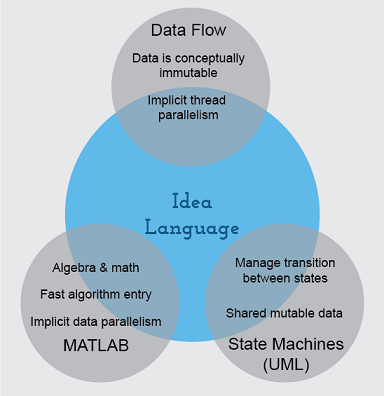Data flow languages Assignment Help
Data flow programming language is based on the flow of data to specify the program. In this programming language computation is modelled as directed graph, the node of which are either data sources or processing elements which compute some function. There are variety of data flow language like Clarion Programming Language, Clipper Programming Language, MUMPS Programming Language etc.
What is Data flow languages?
Data flow languages are a type of programming language that focuses on describing and modeling the flow of data within a system or program rather than specifying the control flow or sequence of operations. In data flow languages, you define how data moves and transforms from one stage to another, and the system automatically manages the execution based on data dependencies.
Here are some key characteristics and concepts associated with data flow languages:
-
Graph-Based Representation: Data flow programs are often represented as directed graphs, where nodes represent operations or transformations, and edges represent the flow of data between them. This graphical representation helps visualize how data moves through the system.
-
Concurrency: Data flow languages are inherently suited for parallel and concurrent execution. As long as the data dependencies are satisfied, multiple operations can be performed simultaneously, making them well-suited for multi-core processors and distributed systems.
-
No Explicit Control Flow: Unlike traditional imperative languages like C++ or Java, data flow languages do not rely heavily on explicit control flow constructs like loops and conditional statements. Instead, the execution order is determined dynamically based on data availability.
-
Reactive Programming: Data flow languages are commonly used in reactive programming paradigms, where the system reacts to changes in data by automatically propagating these changes through the network of operations. This is especially useful in scenarios where real-time data processing or event-driven systems are required.
-
Examples: Some well-known data flow languages and frameworks include Apache NiFi, LabVIEW, TensorFlow (for defining neural network models), and Apache Beam (for data processing pipelines).
-
Visual Programming: In some data flow languages, especially those used in fields like control systems or data analysis (e.g., LabVIEW), programming is done visually by connecting blocks or nodes in a graphical interface, making it more accessible to non-programmers.
-
Data Dependency Management: Data flow languages handle data dependencies automatically. An operation is executed only when its input data or parameters are available and up-to-date. This dependency tracking simplifies error handling and ensures that calculations are performed with the correct data.
-
Stream Processing: Data flow languages are often used in stream processing systems, where data continuously flows through a pipeline, and various operations are applied to it as it moves along.
Data flow languages are particularly useful in scenarios where the data processing logic is complex, data arrives continuously, and you want to take advantage of parallelism and concurrency without explicitly managing threads or processes. They are commonly used in fields like data analytics, signal processing, scientific computing, and real-time control systems.
Data flow languages Assignment Help By Online Tutoring and Guided Sessions at AssignmentHelp.Net
Examples of Data flow Programming Languages

{`
? "Hey!! How R U??"
A simple data base input mask:
USE Student SHARED NEW
clear
@ 1, 0 SAY "StudentNam" GET Student->StudentNam PICT "999999" VALID Student->StudentNam > 0
@ 3, 0 SAY "Contact" GET Student->Contact VALID !empty(Student->Contact)
@ 4, 0 SAY "Address" GET Student->Address
READ
`}
Data flow programming languages are designed to represent and implement systems or algorithms as a directed graph of data dependencies. In these languages, the data flows through a series of processing nodes, where each node performs a specific operation or computation. Here are some examples of data flow programming languages:
-
LabVIEW: LabVIEW is one of the most popular data flow programming languages used in the field of measurement and automation. It's commonly used for controlling hardware and collecting data in scientific and engineering applications.
-
Simulink: Simulink is a data flow and graphical programming environment widely used for modeling, simulating, and analyzing dynamic systems, especially in the field of control engineering.
-
Max/MSP: Max/MSP is a visual programming language and development environment for music, multimedia, and interactive art. It's known for its ability to create complex signal processing chains visually.
-
Pure Data (Pd): Pure Data is similar to Max/MSP and is used for creating interactive multimedia software and multimedia works. It's open-source and has a strong community of users and developers.
-
VHDL (VHSIC Hardware Description Language): VHDL is primarily used for hardware description and design, especially in the context of field-programmable gate arrays (FPGAs). It represents hardware as data flows and states.
-
Verilog: Similar to VHDL, Verilog is a hardware description language used for designing digital systems. It represents hardware components and their interactions through data flow.
-
Nest Gadget: Nest Gadget is a visual programming language designed for IoT (Internet of Things) applications. It enables users to connect hardware devices and create data flow programs to control and monitor them.
-
Node-RED: Node-RED is a flow-based development tool for visual programming. It is often used for IoT and home automation projects to create flows that connect various devices and services.
-
Flow-Based Programming (FBP): While not a specific language, FBP is a paradigm for designing software systems using a data flow approach. It can be implemented in various languages, and there are libraries and tools that support FBP concepts in languages like Java and JavaScript.
-
Kieler/Graphiti: Kieler is a visual language for creating graph-based diagrams, often used in software modeling. Graphiti is a graphical framework for creating diagram editors that can be used for data flow representations.
These languages vary in their domains of application and complexity, but they all share the fundamental concept of representing systems as interconnected nodes or components with data flowing between them.


